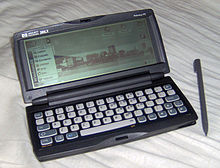
A personal digital assistant (PDA), also known as a handheld PC, is a variety mobile device which functions as a personal information manager. PDAs have been mostly displaced by the widespread adoption of highly capable smartphones, in particular those based on iOS and Android, seeing a rapid decline in use after 2007.
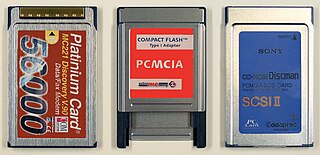
PC Card is a parallel peripheral interface for laptop computers and PDAs.
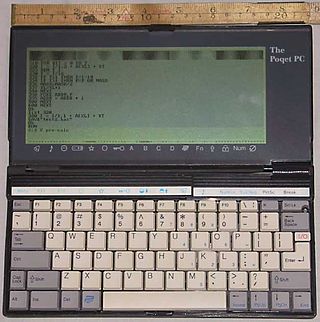
The Poqet PC is a very small, portable IBM PC compatible computer, introduced in 1989 by Poqet Computer Corporation with a price of $2000. The computer was discontinued after Fujitsu Ltd. bought Poqet Computer Corp. It was the first subnotebook form factor IBM PC compatible computer that ran MS-DOS. The Poqet PC is powered by two AA-size batteries. Through the use of aggressive power management, which includes stopping the CPU between keystrokes, the batteries are able to power the computer for anywhere between a couple of weeks and a couple of months, depending on usage. The computer also uses an "instant on" feature, such that after powering it down, it can be used again immediately without having to go through a full booting sequence. The Poqet PC is comparable to the HP 95LX/HP 100LX/HP 200LX and the Atari Portfolio handheld computers.
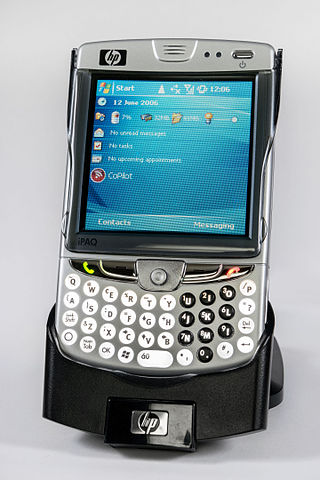
The iPAQ is a discontinued Pocket PC and personal digital assistant which was first unveiled by Compaq in April 2000.
Windows Embedded Compact, formerly Windows Embedded CE, Windows Powered and Windows CE, is a discontinued operating system family developed by Microsoft as part of its Windows Embedded family of products.
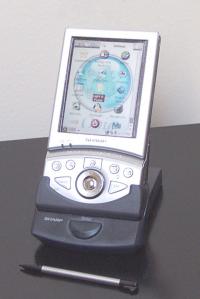
The Sharp Zaurus is the name of a series of personal digital assistants (PDAs) made by Sharp Corporation. The Zaurus was the most popular PDA during the 1990s in Japan and was based on a proprietary operating system. The first Sharp PDA to use the Linux operating system was the SL-5000D, running the Qtopia-based Embedix Plus. The Linux Documentation Project considers the Zaurus series to be "true Linux PDAs" because their manufacturers install Linux-based operating systems on them by default. The name derives from the common suffix applied to the names of dinosaurs.
Casio Cassiopeia was the brand name of a PDA manufactured by Casio. It used Windows CE as the Operating system. Casio was one of the first manufacturers of PDAs, developing at the beginning small pocket-sized computers with keyboards and grayscale displays and subsequently moving to smaller units in response to customer demand.

The Atari Portfolio is an IBM PC-compatible palmtop PC, released by Atari Corporation in June 1989. This makes it the world's first palmtop computer.
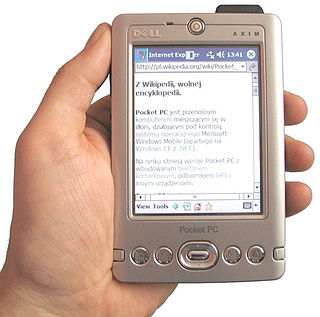
The Dell Axim family of personal digital assistants was Dell's line of Windows Mobile-powered Pocket PC Devices. The first model, the Axim X5, was introduced in 2002, while the final model, the Axim X51, was discontinued on April 9, 2007.

The HP 200LX Palmtop PC, also known as project Felix, is a personal digital assistant introduced by Hewlett-Packard in August 1994. It was often called a Palmtop PC, and it was notable that it was, with some minor exceptions, a MS-DOS-compatible computer in a palmtop format, complete with a monochrome graphic display, QWERTY keyboard, serial port, and PCMCIA expansion slot.
The Psion Series 7 is a subnotebook computer from Psion that was released in 2000. In size it is fairly original: larger than a palmtop or handheld machine, but smaller than a laptop computer. It was the first and last of the Psion series to have a full color electronic visual display. It has a leather-bound clamshell design, with a touch-sensitive, Video Graphics Array (VGA) resolution liquid-crystal display (LCD) and QWERTY computer keyboard. Internally it has a 132.71 MHz StrongARM SA-1100 processor, 16 megabyte (MB) of random-access memory (RAM) and 16 MB of internal read-only memory (ROM).

A handheld personal computer (PC) is a pocket-sized computer typically built around a clamshell form factor and is significantly smaller than any standard laptop computer, but based on the same principles. It is sometimes referred to as a palmtop computer, not to be confused with Palmtop PC which was a name used mainly by Hewlett-Packard.

The SIMpad is a portable computer developed by the company Keith & Koep by order of Siemens AG, with an 8.4" TFT touchscreen. Commonly used with wireless network cards, it was marketed as a device to browse the World Wide Web. Initially announced in January 2001 at the Consumer Electronics Show.

The Jornada was a line of personal digital assistants or PDAs manufactured by Hewlett-Packard. The Jornada was a broad product line that included Palm-Size PCs, Handheld PCs, and Pocket PCs. The first model was the 820, released in 1998, and the last was the 928 model in 2002 when Compaq and HP merged. The Jornada line was then succeeded by the more popular iPAQ model PDAs. All Jornada models ran Microsoft Operating Systems that were based on Windows CE.

The HP 620LX is a palmtop computer that runs Windows CE 2.0 or 2.11. It has a CompactFlash Type I card slot, a PC card slot, a serial link cable plug, and an infrared port. It has 16MB of RAM and a Hitachi SH3 processor running at 75 Mhz. It also has a 256-color display with a resolution of 640x240. The screen is backlit. It is internet capable by attaching an add-on modem or through an Ethernet or Wi-Fi card. Only Type I PC cards are supported, and special drivers for Windows CE are required.

The MobilePro is a discontinued line of personal digital assistants manufactured by NEC. Most models in the MobilePro range were handheld PCs with almost full size keyboards and a compact form placing them between being a palmtop and a subnotebook. All of the models in the MobilePro range ran a version of Microsoft's Windows CE mobile operating system and could be navigated using a stylus and touchscreen.

The Philips Velo was a Handheld PC.
The HP 660LX (F1270A) is a handheld palmtop organizer that runs Windows CE 2.0 or 2.11 that launched in 1998. It is similar to the previous model, the HP 620LX. It has a CompactFlash Type I card slot, a PC card slot, a serial link cable plug, and an infrared port.

The A7000 and A7000+ were Acorn Computers' entry level computers based somewhat on the Risc PC architecture.
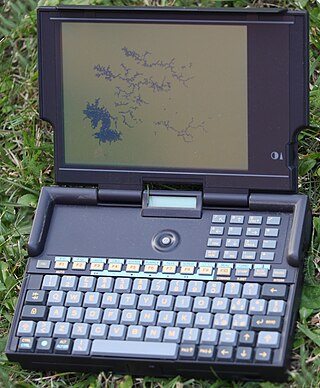
The Quaderno was a subnotebook produced by Olivetti in two versions from 1992: Quaderno (PT-XT-20) and Quaderno 33 (PT-AT-60).
